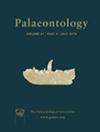How long does a brachiopod shell last on a seafloor? Modern mid‐bathyal environments as taphonomic analogues of continental shelves prior to the Mesozoic Marine Revolution
IF 2.3
2区 地球科学
Q1 PALEONTOLOGY
引用次数: 0
Abstract
Carbonate skeletal remains are altered and disintegrate at yearly to decadal scales in present‐day shallow‐marine environments with intense bioerosion and dissolution. Present‐day brachiopod death assemblages are invariably characterized by poor preservation on continental shelves, and abundant articulated shells of brachiopods with complete brachidia are thus not expected to be preserved if not rapidly buried. However, such preservation is paradoxically observed in shallow‐water Palaeozoic and Mesozoic brachiopod assemblages. Here, we show that a bathyal death assemblage time‐averaged to several millennia (Adriatic Sea) consists of sediment‐filled articulated shells of Gryphus vitreus with complete brachidia. Post‐mortem age distributions indicate that disintegration half‐lives exceed several centuries (c. 500–1700 years). The high frequency of articulated but centuries‐old shells (>50%) and the fitting of taphonomic models to post‐mortem ages indicate that disarticulation half‐life is unusually long (c. 200 years). Rapid sediment filling of shells: (1) inhibited disarticulation, loop fragmentation and colonization by coelobites; and (2) induced precipitation of ferromanganese oxides at redox fronts within shells. Sediment‐filled articulated shells, however, still resided at the sediment–water interface as indicated by encrusters and sponges that infested them after death. Sediment‐filled shells disintegrated through bioerosion and physical wear when residence in the taphonomically active zone exceeded c. 2000 years. We suggest that the articulation paradox is driven by the Mesozoic Marine Revolution (MMR) that escalated predation, bioturbation and organic matter recycling, all intensifying shell disintegration. A scenario with slow disarticulation in bathyal environments may have lead to preservation of articulated shells in shallow‐water assemblages prior to the MMR.一个腕足类动物的壳能在海底停留多久?现代中深海环境与中生代海洋革命前大陆架的类似性
碳酸盐骨骼残骸在当今浅海环境中以每年到十年的规模发生变化和分解,具有强烈的生物侵蚀和溶解作用。目前的腕足类死亡组合在大陆架上的保存状况总是很差,因此,如果不迅速埋葬,那么拥有完整腕足的腕足动物的大量关节壳预计不会被保存下来。然而,这种保存在浅水古生代和中生代腕足动物组合中却被矛盾地观察到。在这里,我们展示了一个平均时间为几千年的深海死亡组合(亚得里亚海),由具完整腕足的玻璃龙的沉积物填充关节壳组成。尸检年龄分布表明,解体半衰期超过几个世纪(约500-1700年 年)。有关节但有数百年历史的贝壳的出现频率很高(>50%),并且埋葬模型与尸检年龄相吻合,这表明关节缺失的半衰期异常长(约200 年)。贝壳的快速沉积物填充:(1)抑制了腔螺的关节分离、环断裂和定殖;和(2)在壳内的氧化还原前沿诱导铁锰氧化物的沉淀。然而,沉积物填充的铰接壳仍然存在于沉积物-水界面,死亡后附着的外壳和海绵表明了这一点。沉积物填充的贝壳在沉积活跃区的停留时间超过2000年时,由于生物侵蚀和物理磨损而解体 年。我们认为,衔接悖论是由中生代海洋革命(MMR)驱动的,该革命加剧了捕食、生物扰动和有机物回收,所有这些都加剧了外壳的解体。在深海环境中缓慢断开关节的情况可能会导致在MMR之前在浅水组合中保存关节式壳体。
本文章由计算机程序翻译,如有差异,请以英文原文为准。
求助全文
约1分钟内获得全文
求助全文
来源期刊

Palaeontology
地学-古生物学
CiteScore
5.60
自引率
3.80%
发文量
43
审稿时长
6 months
期刊介绍:
Palaeontology publishes a wide variety of papers on palaeontological topics covering:
palaeozoology
palaeobotany
systematic studies
palaeoecology
micropalaeontology
palaeobiogeography
functional morphology
stratigraphy
taxonomy
taphonomy
palaeoenvironmental reconstruction
palaeoclimate analysis and biomineralization studies.
 求助内容:
求助内容: 应助结果提醒方式:
应助结果提醒方式:


